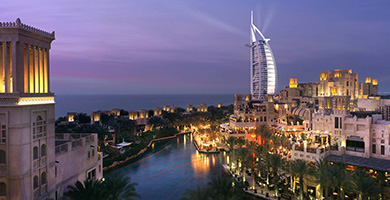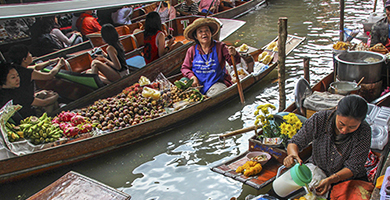Experiencing India the Aman Way
When Indonesian hotelier Adrian Zecha opened the first Aman Resort in Thailand in 1988, he had to ante up the money as no investor saw any profit in a forty-suite property. Since then, Aman Resorts has opened an average of one stunning property a year in Asia and, more recently, resorts in France, the Turks & Caicos, and Jackson Hole, WY. Each follows the same model: intimacy, luxurious simplicity, and unobtrusive service. Visiting an Aman is like like staying at a country house with a caring host, though the furnishings are far superior.
The twentieth Aman resort, a cool oasis at the rambunctious center of New Delhi, opens next month and, two other two Indian properties, Amanbagh and Aman-i-Khas, can be found a couple of hours either side of Jaipur, an easy 40-minute flight from Delhi. Together, they distill the best of this challenging country: urban bustle, sybaritic retreat, and rustic adventure.
The Aman New Delhi, the group’s second city resort and its largest, follows the opening of the Beijing Aman in the former Summer Palace late last year. Australian architect Kerry Hill has designed two multi-storied blocks of pale stone, shaded by perforated screens, that dapple the sunlight on terraces opening out of sixty-seven spacious suites with individual plunge pools—which is great if you want to bathe au naturel. In each, the décor is Zen minimalist—a refreshing change from the ornate excess of many palace hotels in India. The three-level Lodhi restaurant serves a refined Catalan menu upstairs, and tapas, as authentic as you’ll find in Spain, in a cozy basement bar. A casual restaurant provides breakfast as well as light Indian and Thai fare. A lavish spa flanks a sunken pool, a library, and wine-tasting room.

Amanbagh Terrace
After a twenty-hour flight from the US, the simple gestures of welcome draw you into another culture. In Delhi, a hot towel and a lightly-spiced fruit cocktail appear as you get out of the hotel car. At Amanbagh, American designer Ed Tuttle’s inspired recreation of the courtyard houses of Rajasthan, guests are serenaded with a mantra, before being whisked off to a suite of understated elegance for a relaxing soak in a green marble tub. Aman-i-Khas has ten 80-square-meter tents, and arriving at night proves fun as local musicians compete with the chatter of wildlife to entertain guests before a crackling log fire.
The quality of Aman service enhances the overall experience. Staff are recruited locally for their attitude, rather than prior experience, and have an easy relaxed manner, often missed in more conventional hotels. General managers, handpicked by Zecha himself, are chosen for their communication skills and interesting backgrounds like New Delhi’s Anthony Treston, a Brit who previously ran a sporting estate in Ireland; Robyn Bickford, a former Kiwi diplomat, who shares the role with her Indian husband, Manav Garewal at Amanbagh; and Aman-i-Khas’ Gerhard Wiehahn, a Capetown native who hails from a safari resort in the Serengeti. Authorities on local attractions, they will recommend exciting adventures like an open-air jeep ride through neighboring villages where the children gather beside the road to smile and wave, or a trip to the Rathambore Wildlife Park where an encounter with a tiger strolling nonchalantly down the path imprints itself deeply in memory. Amanbagh offers excursions to a legendary city that was cursed by a magician and abandoned three centuries ago, but is now alive with monkeys, or a bird-watching expedition on a nearby lake. Guests enjoy lunch on a canopied Kashmiri boat, shaded with silk gauze, as it is rowed silently across the still waters for a close view of black-headed ibis, egrets, ospreys, and spoonbills. It’s a magical moment and an ideal complement to the cheerful chaos of Indian cities.
The Aman New Delhi, located on Lodhi Road, a thirty-minute drive from the airport, opens on March 1st, and offers an opening rate of $550 a night, rising to $750 in October. Suites at the Amanbagh range from $650 in winter to $550 in summer, and the tents at Aman-i-Khas are $875 from October though April, and are closed during the summer monsoons. Service and government taxes add another 20 per cent. In any other year they’d be solidly booked though the end of the high season in April, but the recession and the Mumbai attack emptied rooms, and you can now reserve all three at a week’s notice.
Photos courtesy of Michael Webb and Aman Resorts.
[simpleflickr set=”72157614318941686″ /]
Michael Webb
around the world.
Latest posts by Michael Webb
- DESTINATION: Revisiting the South of France - April 30, 2024
- Exploring the Czech Republic - January 29, 2024
- Rediscovering Morocco - April 6, 2022




